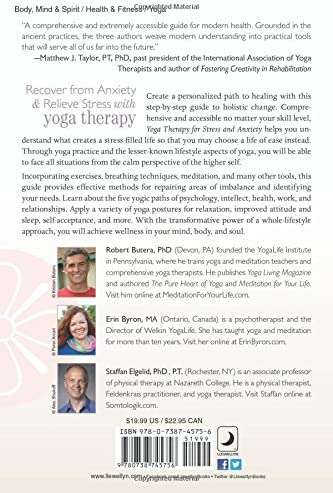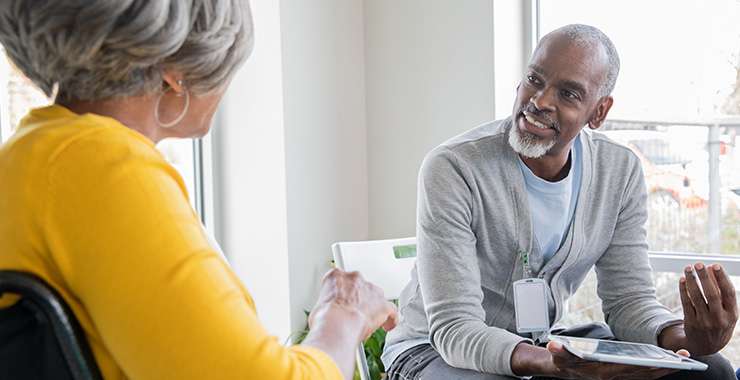
Contents
- Anxiety and Yoga Therapy
- Anxiety Disorders: A Background
- Why Use Yoga as an Adjunct Treatment for Anxiety?
- Growing Clinical Evidence
In recent years, increasing numbers of studies have emerged suggesting that yoga is an effective adjunct therapy for people experiencing anxiety disorders. This guide offers a short introduction to anxiety disorders, as well as the rationale behind including yoga in their treatment.
At some point, everyone experiences feelings of anxiety. From mild nerves to sheer panic, anxiety is a natural response to stressful situations, and one that can help us react appropriately when we are in danger. But for those living with an anxiety disorder, feelings of fear or worry aren’t a rational response to external circumstances – they are a disruptive and dominating influence.
Anxiety and Yoga Therapy
We tend to think of anxiety as a response to stressful circumstances. Whether it’s butterflies in the stomach or can’t-sit-still-nerves, there’s a wide range anxiety we can experience on an occasional basis that is unpleasant, but endurable – and to a certain extent, rational.
In contrast, when people with an anxiety disorder are asked to describe an anxiety attack, they often say a variation of “I thought I was going to die”. Whether it’s a persistent feeling of dread or intermittent panic, the hyperarousal of the fight/flight survival response creates a feeling of urgent fear and unignorable physical symptoms. So how can someone begin to calm down when their body is telling them that they are in mortal danger?
“Meditation, visualization, and focusing on breathing can help with letting go of worry and fear. The overall practice of yoga can elicit the relaxation response, allowing both the body and mind to gain a sense of calm and ease.”
Katharina Star, PhD. Counsellor Specialising in Anxiety
Yoga therapy can help people in this situation because they aren’t being asked to rationalise their way out of anxiety. Instead, they are given tools that help them recognise the thoughts, feelings and actions that lead to heightened anxiety, and enact effective self-soothing methods. In a yoga class, they are also unconsciously learning to regulate their stress response and building resilience to stress.
Someone who suffers with mild or subclinical experiences of anxiety may find support in a general yoga class. For those whose anxiety is more severe, however, a specialised course of yoga therapy (administered by highly-trained yoga professionals that understand the physical and psychological mechanisms of anxiety disorders) may be more appropriate.
Anxiety Disorders: A Background
An umbrella term for a variety of mental health conditions, anxiety disorders share similar symptoms and traits – such as distress, sleep disturbances and difficulty in fulfilling social/occupational roles. They are also amongst the most commonly diagnosed mental health issues in the UK.
“Anxiety disorders have been associated with significant long-term disability. They can be distressing for the person affected, their families, friends and carers, and can have an impact on their local communities.”
NICE Guidelines
There are seven anxiety spectrum disorders (which include generalised anxiety disorder, panic disorder and phobias) with a high incidence of co-occurrence between them – possibly because the existence of one anxiety disorder can trigger or contribute to the development of another.
For instance, someone with panic disorder may become housebound (a.k.a agoraphobic) in an attempt to avoid panic attacks, while someone with agoraphobia may experience repeated panic attacks (and therefore panic disorder) when faced with the possibility of going outside.
Anxiety disorders also appear in conjunction with other mental health issues, and often co-occur with Major Depressive Disorder (MDD). According to the Anxiety and Depression Association of America, nearly one-half of those diagnosed with depression are also diagnosed with an anxiety disorder.
There are two possible explanations for the high levels of co-occurrence in anxiety and depression. It’s thought that people with anxiety may also be vulnerable to developing depression due to genetics, upbringing and environment – in short, that the two conditions share the same risk factors. However, it’s also possible that anxiety disorders have such an adverse impact on people’s lives that feelings of shame, hopelessness and low mood are a prevailing consequence.
In 2013, 8.2 million cases of anxiety were recorded in the UK. While some people present at A&E, (with shortness of breath, acute chest pain and a racing heartbeat convincing some – not unreasonably – that they are in physical danger) most people with anxiety will seek medical help through their GP. In the treatment of anxiety disorders, the NICE guidelines currently advise GPs to provide medication and/or a referral to high-intensity psychological intervention, as well as some self-help advice.
Cognitive Behavioural Therapy and applied relaxation techniques are often recommended, while SSRIs (a class of antidepressants) are the first line in pharmacological treatment. Those with severe anxiety may also be prescribed benzodiazepines – which act as an immediate anxiolytic – to alleviate short-term crises and help them move on to further treatment, but this is used in a limited fashion due to the potential for dependance. Beta-blockers can also be used to reduce heart rate.
In the treatment of anxiety disorders, no single treatment works for everyone, and people may try a variety of medications and therapies before finding what most helps them manage (or recover from) this illness.
Why Use Yoga as an Adjunct Treatment for Anxiety?
Yoga leads to a cessation of the fluctuations of the mind
Pantanjali
The impact of anxiety can be severe, and there are times that people feel dissatisfied with the solutions they are currently presented. While medication is often a vital part of any treatment plan, patients can sometimes be uncomfortable with side-effects or the thought of a difficult withdrawal. According to Baldwin and Polkinghorn (2005), 50% of people prescribed pharmacological intervention reported an improvement in symptoms, and a US-based study concluded that up to 30% of patients may be “treatment resistant” – finding front-line interventions ineffective.
This goes some way to explain why 56% of those living with anxiety disorders seek complementary and alternative medicine (1) – hinting at a widespread desire for further support outside of traditional treatment plans. With a growing body of scientific literature to guide clinical practice in applying yoga as a treatment of anxiety, yoga therapy can step into this gap and provide additional support – helping people regulate their stress response, increase their resiliency and manage their anxiety.
When informed by research and applied by qualified professionals, yoga therapy for anxiety is a safe and inexpensive treatment option that people can use over the long-term. While an ancient practice, remarkably Patanjali’s eightfold system of yoga contains many elements used in modern treatments for anxiety: cognitive reframing, behavioural recommendations, relaxation techniques focused on breath regulation, mindfulness of sensory input, as well as methods for greater cognitive flexibility, concentration and downregulation of distress.
“Some postures are challenging, but you are learning to relax under physical duress and this can help you handle long-term anxiety.”
Heather Mason
There may be cases where yoga can be appropriately applied as a primary treatment in response to anxiety disorders, but in most cases, it’s the integration of yoga with psychotherapy and pharmaceutical intervention that could significantly support recovery. Breathing techniques in particular offer a method through which people can reduce their anxiety in the short term, allowing them to properly engage with other therapeutic practices. Along with basic movements and yogic relaxation techniques, these can easily become a part of a wide array of treatment pathways.
As a mind-body practice, yoga allows people to become aware of the link between their minds and bodies in a way which can help them become less anxious. For example, shallow breathing may contribute to a heightened stress response, or repeated patterns of behaviour might ultimately worsen overall anxiety (for instance, relying on alcohol to calm down). Yoga increases mind-body awareness, as well as offering a form of relaxation which can replace unhealthy coping mechanisms.
Growing Clinical Evidence
Various studies have been completed which point to the clinical value in including yoga in anxiety treatment. One such example included a 12-week yoga intervention, which was was associated with greater improvements in mood and anxiety than a metabolically matched walking exercise. (2) After a 10-week yoga programme, other researchers concluded that yoga can reduce stress, anxiety and improve health status in several key domains. (3).
In Germany in 2005 24 women who described themselves as ‘emotionally distressed’ took two 90-minute yoga classes a week for three months, while a control group maintained their usual activities without engaging in an exercise or stress-reduction program during. At the end of the three months, the women in the yoga group reported improvements in perceived stress, depression, anxiety, energy, fatigue and well-being. Most impressively, depression scores improved by 50% and anxiety scores by 30%. (4)
If you’re a yoga, health or psychology professional (or other interested party) and would like to find out more about how yoga can be used to help your clients, you can read more about the use of yoga therapy in the treatment of anxiety with Yoga for Mental Health. If you are experiencing an anxiety disorder and are interested in working with a yoga therapist, please see our Minded Clinic.
(Kessler, R. C., Soukup, J., Davis, R. B., Foster, D. F., Wilkey, S. A., van Rompay, M.i., & Eisenberg, D. M. (2001) The use of complementary and alternative therapies to treat anxiety and depression in the United States. American Journal of Psychiatry)
Streeter, C. C., Whitfield, T. H., Owen, L., Rein, T., Karri, S. K., Yakhkind, A., & Jensen, J. E. (2010). Effects of yoga versus walking on mood, anxiety, and brain GABA levels: a randomized controlled MRS study. The Journal of Alternative and Complementary Medicine, 16(11), 1145-1152.
Smith, C., Hancock, H., Blake-Mortimer, J., & Eckert, K. (2007). A randomised comparative trial of yoga and relaxation to reduce stress and anxiety. Complementary therapies in medicine, 15(2), 77-83
Brown, R. P., & Gerbarg, P. L. (2005). Sudarshan Kriya Yogic breathing in the treatment of stress, anxiety, and depression: part II—clinical applications and guidelines. Journal of Alternative & Complementary Medicine, 11(4), 711-717.



